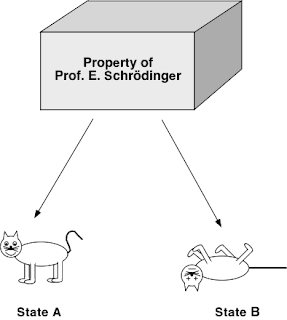 Dear X___,
Dear X___,I forget what we were talking about, but some time ago I mentioned that an observed object differs in substance from that same object unobserved. The idea is based upon Werner Heisenberg prinicples, the Copenhagen Interpretation ("In effect, the act of measurement causes the calculated set of probabilities to "collapse" to the value defined by the measurement.") and is illustrated by Schroedinger's Cat.
I think that you expressed interest in this concept and asked me, at the time, to send you something about this. Here, belatedly, is that information.
"The quantum reality problem arises primarily because quantum theory describes the world in two ways, not one. Quantum theory represents an object differently depending on whether it is being observed or not being observed. Every physicists without exception uses this twofold quantum description in his or her own work, but physicists hold many divergent opinions about "what is actually going on" during these two stages in an object's existence: being observed and not-being-observed.
 Whenever an object--bulldog, baseball, or baryon--is not under observation, quantum physicists represent that object as a "wave of probability", called the object's "wave function". instead of definite values for attributes such as position, velocity and spin, each of the object's attributes takes on--in the mathematics at least--a wide range of possible values, values that oscillate in a wavelike manner at a variety of different frequencies. This way of treating unobserved objects is one of quantum theory's most peculiar features. Physicists treat an unobserved object not as a real thing but as a probability wave, not as an actiual happening but only as a bundle of vibratory possibilities.
Whenever an object--bulldog, baseball, or baryon--is not under observation, quantum physicists represent that object as a "wave of probability", called the object's "wave function". instead of definite values for attributes such as position, velocity and spin, each of the object's attributes takes on--in the mathematics at least--a wide range of possible values, values that oscillate in a wavelike manner at a variety of different frequencies. This way of treating unobserved objects is one of quantum theory's most peculiar features. Physicists treat an unobserved object not as a real thing but as a probability wave, not as an actiual happening but only as a bundle of vibratory possibilities.On the other hand, when an object is observed, it always manifests at one particular place, with one particular spin and velocity, instead of a smeared-out range of physical properties. During the act of measurement, the mathematical description abruptly shifts--from a spread-out range of possible attributes (unmeasured object) to single-valued actual attributes (measured object). This sudden measurement-induced switch of descriptions is called "the collapse of the wave function", or simply "the quantum jump". What actually happens during a quantum jump is the biggest mystery in quantum physics. Whether this drastic shift in the mathematical description corresponds to an actual dislocation in the real world or is a purely mathematical quirk continues to be a matter of deep controversy in the physics community." - http://quantumtantra.com/werner.html
Of course, some would say, that nothing exists in an unobserved state. That is, there is always something that fulfills the role of observer (the box observes the cat, the cat observes itself) and, thus, if there is such a thing as wave function collapse, it has always already occurred before our own observation is added.
Wikipedia is a decent source for summaries of the fundamental concepts.
Peace,
Dennis

1 comment:
I think the best description of quantum physics and the role of the observer is:
If a tree falls in the forest and it falls on a mime, does anybody care?
Post a Comment